Friday, June 28, 2013
Samsung Galaxy S4 vs Galaxy S III: Advanced fence-sitting
Introduction
Upgrader's dilemmas. We've had a few of those over the years but, every once in a while, deciding between the next generation and the last transcends the limits of a brand. By consistently delivering the goods, the Galaxy line has become synonymous with the best that Android has to offer. Now, it's a huge reputation to live up to and it's only getting harder for every new flagship.
With millions of Galaxy S4's being packaged as we speak and prepared for shipping, it's the time for hard choices. Very much so for Galaxy S III owners - about 50 million of them on latest account. Upgrade or stay put? Tough one.
Or is it? For smartphone geeks it borders on a no-brainer. It's the newer model that flaunts a full-HD five-incher and an immensely powerful chipset, with a 13MP camera and a host new software tricks to boot. Those should be enough of a nudge to get fence-sitters on the right side of the fence. Which, from Samsung's perspective, is the side of the Galaxy S4.
That's the thing, though. It's the manufacturer's job to always get people interested in the latest. You on the other hand, want to know if they're getting enough in return for their hard-earned cash. You may still end up buying a new model every year, but it should be a choice not a compulsion.
Samsung Galaxy S4 over Samsung Galaxy S III
- 5" 1920 x 1080 Super AMOLED display with ~441 ppi density, Gorilla Glass 3 (over 4.8" 720p ~306 ppi on the S III)
- Quad-core Snapdragon 600 or Exynos 5 Octa chipset
- 2 GB of RAM on all models (only the US LTE-capable S III has 2 GB RAM)
- 13 MP camera (8 MP on the S III)
- 2 MP 1080p front-facer (1.9 MP 720p on the S III)
- Temperature and humidity sensors
- Wireless charging
- Air gestures, smart gestures (some may eventually come to the S III)
- Wi-Fi ac, faster HSDPA (42.2 Mbps over 21 Mbps on the S III)
- LTE on all models
- More compact, thinner and slightly lighter body (7.9 mm vs 8.6 mm, 130 g vs 133 g)
- Higher-capacity battery (2600 vs 2100 mAh)
Samsung Galaxy S III over Samsung Galaxy S4
- Cheaper
- FM radio
- Will eventually receive most of the TouchWiz novelties via update
- Wider field of view in camera and camcorder
The screen is a significant step up from the previous model too - it's crisper, having more than double the amount of pixels, superior brightness and colors and, not least of all, does have that precious extra room for even better productivity and multimedia experience.
On the software front, there are air gestures, eye tracking, face tracking, Smart Pause. Features that elevate the TouchWiz experience above the rest in terms of both usability and novelty, but at least some of them will eventually land on the Galaxy S III too.
So, while it's clear that the Galaxy S4 is in many ways superior to the Galaxy S III, it's equally easy to turn that around and say that both phones share many similarities. Both will be running the latest Android software when the Galaxy S III gets its promised update and both have great Super AMOLED screens, capable processors, expandable storage, solid battery life and stellar cameras.




Both phones at HQ
There a significant price gap between the two as well and that's another important part of the decision-making. So, while it's not impossible to put a price on improvements like to the screen, camera, processing power, audio quality and the like, the hard bit is for every user to do their own math and decide whether the premium charged is worth it. We'll try to cover every important aspect of the experience these two can provide and hopefully get most of your questions answered. We're back after the break with the design and build overview.
Hardware
The Samsung Galaxy S4 didn't stray too far from the design ideas of its predecessor. The Galaxy S III introduced the "inspired by nature" philosophy and the hyperglaze finish, which have been carried over to virtually every Samsung smartphone released since, including the Koreans' new flagship.The Galaxy S4 body uses the same hyperglazed polycarbonate plastic, although it comes with a new crosshatch texture, which we find more attractive than the bruised aluminum finish of the Galaxy S III. It gives the smartphone a more serious and sophisticated look.




The Samsung Galaxy S4 and Galaxy S III side by side
A couple of other factors that contribute to the superior look of the Galaxy S4 compared to the Galaxy S III are the far slimmer bezels around the screen and the slimmer profile. Both factors are crucial to the
high-end vibe and improve not only the design but also the feel of the smartphone.
The fact that the Galaxy S4 is slightly shorter, noticeably thinner and virtually the same width as the Galaxy S III, despite the 0.2" larger screen and the ampler battery is probably Samsung's biggest achievement as far as hardware is concerned.
Finally, the chrome rim around the display on the Galaxy S4 isn't plastic this time and made of some kind of metal instead. The cooler material gives immediate higher-quality reassurance when you start to operate the device.




The bezels around the screens
When comparing the Galaxy S4 to its predecessor the one thing that comes to your attention is the slightly raised frame of the new flagship. Unlike the Galaxy S III, your finger doesn't slide from the edge of the screen but stops at the metal border.



The Samsung Galaxy S4
The Samsung Galaxy S III will be more pleasing to those who prefer a rounder profile and less pointy edges. We can also vouch that after almost a year of use the buttons on the Galaxy S III still feel like new and even except for a scratched area at the back, the plastic hasn't suffered major wear and tear.



The Samsung Galaxy S III
The buttons on the Galaxy S4 are also somewhat refined compared to those on its predecessor. They provide better feedback and generally appear higher-quality. The volume rocker is also longer making it easier to locate and press.




Galaxy S4 buttons
On the back very little has changed. The single LED flash has been relocated under the lens and, more importantly, it turned out to be a bit more powerful than the one on the Galaxy S III. The loudspeaker has been moved to the bottom of the Galaxy S4's back panel and not next to the lens like before.
Unfortunately , the back panel is still a pretty strong fingerprint magnet, so unless you go for the white version, which does much better at hiding those, you will be doing quite a lot of cleaning.




Both phones from the back
Under the hood we find the same slots but at different places. There's a microSIM and microSD card slots, the NFC antenna and the battery. The battery on the Galaxy S4 has gained 500 mAh, which come in handy considering the larger screen and the higher resolution.


Under the hood
Overall, while the Samsung Galaxy S4 didn't bring the complete design overhaul many were asking for, it improves on the hardware of its predecessor quite significantly. The two may look similar from a distance, but hold them in your hand and you'll immediately notice the difference. It may be just an evolutionary step, but it's a pretty big upgrade nonetheless and one that proves 5" smartphones with large batteries don't necessarily have to be unwieldy.
Display
One of the most notable upgrades brought by the Samsung Galaxy S4 is the screen. The Super AMOLED panel is every bit as great as its specs sheet suggests. It offers virtually limitless contrast, vibrant colors and is as sharp as it gets.The diagonal has been increased from 4.8" to 5", and while this isn't a huge difference by any standard more is always better when talking screen estate (as long as you find the balance with the size of the actual device, of course). The resolution has been bumped from 720 x 1280 pixels to 1080 x 1920 pixels, bringing the pixel density to around 441, a massive improvement over the 306ppi density of the Galaxy S III screen.



The Galaxy S4 and Galaxy S III screens
Both screens employ Pentile matrices but at such high densities the dreaded crosshatch pattern isn't really an issue. In fact the Samsung flagship is probably the one to befit the most of the new 1080p trend, as individual pixels are impossible to spot on the Galaxy S4 despite the two-subpixels-per-pixel screen. It's not they were prominent on the Galaxy S III either, but if you looked from very closely you could see some dottiness. So at this point one of the main arguments against the AMOLED technology has been eradicated.


Samsung Galaxy S4 vs Galaxy S III screens under a microscope
More impressively, the other shortcoming of the AMOLED panels, their oversaturated colors, have been taken care of as well. Samsung lets you select between four display modes for your Galaxy S4, including a dedicated Adobe RGB mode, which provides very accurate color reproduction. Naturally, those that are fond of the extra punchy colors can also opt for one of the livelier options, so the Galaxy S4 screen really brings the best of both worlds.
We also noticed that the screen on the Galaxy S4 is slightly brighter than that of its predecessor. Keep in mind that you need to disable the auto adjust screen tone option to get the maximum brightness.
| Display test | 50% brightness | 100% brightness | ||||
| Black, cd/m2 | White, cd/m2 | Black, cd/m2 | White, cd/m2 | |||
| HTC One | 0.13 | 205 | 1580 | 0.42 | 647 | 1541 |
| HTC Butterfly | 0.14 | 173 | 1200 | 0.45 | 501 | 1104 |
| Samsung I9505 Galaxy S4 | 0 | 201 | ∞ | 0 | 404 | ∞ |
| Samsung I9300 Galaxy S III | 0 | 174 | ∞ | 0 | 330 | ∞ |
| Sony Xperia Z | - | - | - | 0.70 | 492 | 705 |
| Oppo Find 5 | 0.17 | 176 | 1123 | 0.51 | 565 | 1107 |
| Samsung N7100 Galaxy Note II | 0 | 215 | ∞ | 0 | 402 | ∞ |
| LG Optimus G Pro | - | - | - | 0.41 | 611 | 1489 |
| Nokia Lumia 920 | - | - | - | 0.48 | 513 | 1065 |
| LG Optimus G | 0.14 | 197 | 1445 | 0.33 | 417 | 1438 |
| Apple iPhone 5 | 0.13 | 200 | 1490 | 0.48 | 640 | 1320 |
Viewing angles on the Galaxy S4 are superb as expected. In direct sunlight the contrast is a little lower than that of the Galaxy S III but not by much so you're getting more or less the same sunlight legibility. Perhaps, the new Gorilla Glass causes a dash of extra reflections and offsets the brightness advantage of the new Samsung flagship.
Sunlight contrast ratio
- Nokia 808 PureView
4.698 - Apple iPhone 5
3.997 - Samsung I9300 Galaxy S III
3.419 - Samsung I9500 Galaxy S4
3.352 - Samsung Omnia W
3.301 - Samsung Galaxy S
3.155 - Nokia N9
3.069 - Samsung Galaxy Note
2.970 - HTC One S
2.901 - Samsung Galaxy S II
2.832 - Samsung Galaxy S II Plus
2.801 - Huawei Ascend P1
2.655 - Nokia Lumia 900
2.562 - HTC One
2.504 - Sony Xperia Z
2.462 - Samsung Galaxy S III mini
2.422 - Motorola RAZR i
2.366 - Samsung Galaxy Note II
2.307 - Apple iPhone 4S
2.269 - HTC One X
2.158 - Nokia N8
2.144 - Oppo Find 5
2.088 - BlackBerry Z10
2.051 - Apple iPhone 4
2.016 - Sony Ericsson Xperia ray
1.955 - Samsung Galaxy Camera
1.938 - HTC Butterfly
1.873 - Sony Xperia V
1.792 - Sony Xperia U
1.758 - LG Optimus 4X HD
1.691 - HTC One V
1.685 - LG Optimus Vu
1.680 - HTC Desire V
1.646 - LG Optimus G Pro
1.552 - LG Optimus 3D
1.542 - Nokia Asha 302
1.537 - Nokia Lumia 610
1.432 - Gigabyte GSmart G1355
1.361 - HTC Desire C
1.300 - LG Optimus L7
1.269 - LG Optimus L9
1.227 - Meizu MX
1.221 - Sony Xperia E dual
1.203 - Samsung Galaxy Pocket
1.180 - Sony Xperia tipo
1.166 - Samsung Galaxy mini 2
1.114
Battery life
The latest Samsung flagship brings a notable upgrade in the battery department. The Galaxy S4 has a 2600 mAh battery versus a 2100 mAh unit on the Galaxy S III. We were curious to see how that balances with the brighter and larger screen of higher resolution and the new chipset, which while built on a new 28nm process is still supposedly drawing more power than the Exynos 4412 inside the Galaxy S III.As it turns out the extra battery supply more than makes up for the extra power demands of the Galaxy S4 and the new Samsung flagship posted some impressive numbers in our test.
Not quite surprisingly, the Galaxy S4 managed to better the achievement of its predecessor in the talk time test quite significantly. With the screen switched off and the chipset not having much to do the Galaxy S4 reached an impressive 13h 53min versus the 10h 15min of the Galaxy S III.
Talk time
- Motorola RAZR MAXX (ICS)
21:18 - LG Optimus G Pro
20:45 - Motorola DROID RAZR MAXX
20:24 - Motorola RAZR i
20:07 - Samsung Galaxy Note II N7100
16:57 - Sony Xperia Z
16:03 - LG Optimus G
15:30 - Nokia Lumia 620
14:17 - Oppo Find 5
14:17 - Google Nexus 4
14:17 - Samsung Galaxy S4
13:53 - HTC One
13:38 - HTC One X+
13:31 - Samsung Galaxy Grand Duos
12:45 - Huawei Ascend P1
12:30 - HTC Butterfly
12:18 - Samsung Galaxy Note
12:14 - Samsung I8530 Galaxy Beam
11:58 - Samsung Galaxy Premier
11:30 - Asus Padfone 2
11:20 - HTC Droid DNA
11:07 - HTC Windows Phone 8X
11:07 - Samsung Wave 3 S8600
11:07 - Samsung I9105 Galaxy S II Plus
11:06 - HTC Desire X
11:03 - HTC One X (AT&T, LTE)
10:35 - Samsung I9300 Galaxy S III
10:20 - Samsung I9300 Galaxy S III (JB)
10:15 - Samsung Galaxy Xcover 2
10:03 - HTC One V
10:00 - Meizu MX 4-core
10:00 - Samsung Galaxy Express
10:00 - HTC One X
9:57 - HTC One S
9:42 - Samsung I9103 Galaxy R
9:40 - HTC Sensation XL
9:30 - Nokia Lumia 810
9:05 - Nokia Lumia 710
9:05 - Acer CloudMobile S500
9:05 - Motorola Atrix HD
9:04 - HTC Vivid
9:02 - Nokia Lumia 920
8:56 - Nokia Lumia 610
8:51 - HTC Rhyme
8:48 - Apple iPhone 5
8:42 - LG Optimus 3D Max P720
8:42 - Sony Ericsson Xperia neo V
8:41 - Meizu MX
8:39 - Samsung Galaxy S II
8:35 - Samsung Galaxy S Duos
8:28 - Nokia Lumia 800
8:25 - Samsung Galaxy Nexus
8:23 - Nokia Lumia 510
8:22 - BlackBerry Z10
8:20 - HTC Desire V
8:20 - Samsung Captivate Glide
8:20 - Sony Xperia T
8:15 - HTC Rezound (LTE)
8:10 - Samsung Galaxy Note (LTE)
8:02 - LG Optimus Vu
7:57 - LG Optimus 4X HD
7:41 - Apple iPhone 4S
7:41 - Samsung i937 Focus S
7:25 - HTC Evo 4G LTE (LTE)
7:21 - Samsung Galaxy S Blaze 4G
7:14 - Nokia Lumia 820
7:09 - Sony Xperia acro S
7:09 - Samsung Rugby Smart I847
7:09 - Sony Ericsson Xperia Pro
6:57 - Nokia N9
6:57 - HTC Radar
6:53 - Samsung Galaxy Ace Duos
6:53 - BlackBerry Curve 9380
6:52 - Sony Xperia E dual
6:42 - Samsung Galaxy S III mini
6:22 - Samsung Galaxy Pocket
5:54 - Nokia Lumia 900 for AT&T (LTE)
5:53 - Sony Xperia ion LTE
5:52 - Sony Xperia P
5:33 - Nokia 808 PureView
5:16 - LG Nitro HD (LTE)
5:16 - HTC Titan II (LTE)
5:10 - BlackBerry Bold 9790
5:00 - Pantech Burst
4:46
Web browsing
- HTC One
9:58 - Apple iPhone 5
9:56 - Motorola RAZR MAXX (ICS)
9:12 - Apple iPad mini
9:05 - Samsung Galaxy Note II N7100
8:48 - Samsung Galaxy S4
8:42 - Nokia Lumia 810
8:20 - Asus Padfone 2
8:20 - Nokia Lumia 610
8:01 - HTC One X+
7:56 - Sony Xperia E dual
7:42 - Samsung Galaxy S III mini
7:38 - Motorola DROID RAZR MAXX
7:23 - HTC Radar
7:17 - Samsung Galaxy Grand Duos
7:09 - Samsung Galaxy Express
7:09 - Motorola RAZR i
7:06 - Apple iPhone 4S
6:56 - HTC One V
6:49 - LG Optimus G Pro
6:40 - Samsung I9105 Galaxy S II Plus
6:40 - HTC Droid DNA
6:40 - Samsung Galaxy Premier
6:40 - Motorola Atrix HD
6:40 - BlackBerry Curve 9380
6:40 - Sony Xperia Z
6:37 - Samsung Galaxy Xcover 2
6:35 - BlackBerry Z10
6:27 - Samsung I9300 Galaxy S III (JB)
6:27 - HTC Butterfly
6:24 - Samsung i937 Focus S
6:15 - Nokia Lumia 510
6:13 - HTC Windows Phone 8X
6:01 - Sony Xperia ion LTE
5:56 - Samsung Rugby Smart I847
5:53 - Pantech Burst
5:51 - Samsung Galaxy S Blaze 4G
5:45 - HTC Desire V
5:44 - HTC Evo 4G LTE
5:41 - Nokia Lumia 920
5:40 - Samsung Wave 3 S8600
5:34 - Oppo Find 5
5:33 - Sony Xperia T
5:33 - Samsung Captivate Glide
5:33 - Samsung I8530 Galaxy Beam
5:28 - Samsung Galaxy Note LTE
5:24 - Samsung Galaxy S Duos
5:23 - HTC Sensation XL
5:20 - Meizu MX 4-core
5:19 - Samsung I9300 Galaxy S III
5:17 - Sony Xperia acro S
5:16 - HTC Rezound
5:16 - HTC Desire X
5:16 - LG Optimus G
5:15 - HTC Rhyme
5:08 - Samsung I9103 Galaxy R
5:07 - HTC One X (AT&T)
5:03 - Sony Ericsson Xperia Pro
4:50 - LG Optimus Vu
4:49 - HTC Vivid
4:46 - Samsung Galaxy Ace Duos
4:45 - Meizu MX
4:35 - Google Nexus 4
4:34 - Nokia N9
4:33 - Acer CloudMobile S500
4:32 - Nokia Lumia 820
4:24 - Samsung Galaxy S II
4:24 - Sony Ericsson Xperia neo V
4:20 - HTC One X
4:18 - Nokia 808 PureView
4:14 - LG Optimus 3D Max P720
4:10 - Nokia Lumia 900 for AT&T
4:10 - Nokia Lumia 800
4:07 - HTC Titan II (LTE)
4:05 - HTC One S
4:03 - BlackBerry Bold 9790
4:02 - LG Nitro HD
4:00 - LG Optimus 4X HD
3:59 - Sony Xperia P
3:59 - Nokia Lumia 710
3:51 - Nokia Lumia 620
3:50 - Samsung Galaxy Pocket
3:47 - Samsung Galaxy Note
3:35 - Huawei Ascend P1
3:23 - Samsung Galaxy Nexus
3:01
Video playback
- Motorola RAZR MAXX (ICS)
16:35 - Motorola DROID RAZR MAXX
14:17 - Apple iPad mini
12:51 - Samsung Galaxy Premier
12:51 - Samsung Galaxy Note II N7100
11:27 - Samsung Galaxy S4
10:16 - Apple iPhone 5
10:12 - HTC One
10:02 - Samsung I9300 Galaxy S III
10:01 - Samsung Galaxy Express
10:00 - Samsung I9105 Galaxy S II Plus
10:00 - Nokia 808 PureView
9:53 - Samsung I8530 Galaxy Beam
9:42 - Samsung Rugby Smart I847
9:34 - HTC One S
9:28 - Samsung I9300 Galaxy S III (JB)
9:27 - Apple iPhone 4S
9:24 - HTC Evo 4G LTE
9:07 - BlackBerry Z10
8:44 - LG Optimus G Pro
8:40 - Nokia N9
8:40 - HTC Butterfly
8:28 - Samsung Galaxy Note
8:25 - Samsung Galaxy Grand Duos
8:11 - HTC One X+
8:11 - Motorola RAZR i
8:11 - Samsung Galaxy S II
8:00 - Samsung i937 Focus S
7:55 - Samsung Wave 3 S8600
7:52 - Samsung Galaxy S III mini
7:46 - Sony Ericsson Xperia neo V
7:45 - Asus Padfone 2
7:38 - Huawei Ascend P1
7:38 - Samsung Galaxy S Blaze 4G
7:33 - HTC Droid DNA
7:30 - Samsung Galaxy Note LTE
7:30 - Samsung Galaxy Xcover 2
7:30 - Nokia Lumia 610
7:23 - LG Optimus G
7:16 - Meizu MX 4-core
6:33 - Nokia Lumia 620
6:32 - HTC Windows Phone 8X
6:27 - Sony Xperia E dual
6:27 - Nokia Lumia 810
6:27 - HTC Desire V
6:26 - HTC One X (AT&T)
6:26 - Nokia Lumia 820
6:25 - Samsung Galaxy Ace Duos
6:25 - Nokia Lumia 510
6:23 - LG Optimus Vu
6:23 - Samsung I9103 Galaxy R
6:21 - Nokia Lumia 920
6:19 - HTC Sensation XL
6:12 - Samsung Galaxy Pocket
6:06 - Samsung Captivate Glide
6:04 - Sony Xperia ion LTE
6:03 - Samsung Galaxy Nexus
6:02 - Sony Xperia T
6:01 - Motorola Atrix HD
6:01 - HTC Vivid
6:00 - HTC Radar
5:54 - Nokia Lumia 800
5:52 - HTC Titan II
5:50 - BlackBerry Bold 9790
5:47 - HTC One X
5:45 - Sony Ericsson Xperia Pro
5:44 - Sony Xperia Z
5:39 - Sony Xperia acro S
5:38 - HTC Desire X
5:38 - Pantech Burst
5:38 - Meizu MX
5:27 - HTC Rhyme
5:23 - HTC One V
5:20 - Acer CloudMobile S500
5:18 - Oppo Find 5
5:18 - Nokia Lumia 900 for AT&T
5:18 - BlackBerry Curve 9380
5:09 - HTC Rezound
5:03 - Google Nexus 4
4:55 - Samsung Galaxy S Duos
4:30 - Sony Xperia P
4:30 - LG Nitro HD
4:17 - LG Optimus 4X HD
4:14 - LG Optimus 3D Max P720
3:28 - Nokia Lumia 710
3:27


Software and features
Both smartphones run Android Jelly Bean, but at least for now, different versions of it - the Galaxy S III is powered by Jelly Bean 4.1.2, while the Galaxy S4 will launch with version 4.2.2, which is the latest available to date. The Galaxy S4 rocks the later version of TouchWiz, too. It brings a plethora of new features, some of which will eventually hit the Galaxy S III, too, but for now are exclusive to the latest flagship.Air gestures, Smart scroll and quick glance to name just a few, but before we start examining those, here are both the Galaxy S III and Galaxy S4 with their relative TouchWiz UI versions on video.
The differences between the two start right at the lockscreen, where the Galaxy S4 takes advantage of its Android 4.2.2 Jelly Bean build. Thanks to it, the new Samsung flagship offers the so-called lockscreen widgets. The lockscreen has multiple panes, each containing one widget. The page to the right of the default one is special and can either be a list of favorite apps (the default TouchWiz setting) or a shortcut for the camera (as in pure Android).




New and old lockscreens compared
The default lockscreen shows the time along with a personal message overlaid on beautiful photos pulled from TripAdvisor (with text at the bottom telling you where the photo was taken). Additionally, the water ripples seen on the Galaxy S III have been replaced by a lens flare effect though, if you prefer, you can switch back to the old one or disable it all together.
The latest TouchWiz version on the Galaxy S4 offers another cool options for the lockscreen dubbed Auto unlock zone. You can add several "home" Wi-Fi networks and the lockscreen passcode will be disabled when your Galaxy S4 hooks up to one of them. This way you can have a secure PIN lockscreen outside and a quick unlock at home or the office.




The lockscreen shows beautiful photos and cool widgets
There's also the Quick glance feature on the Galaxy S4. It's neat trick that the Galaxy S4 has learned from the Note II, which uses the proximity sensor to detect when you're reaching for the device and lights up a portion of the screen with cool glow effect. The lit area shows you the time, missed calls, message counters, battery charge and music track info.
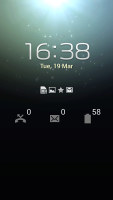
Quick glance
You can still place app shortcuts at the bottom of the lockscreen on both phones. Notably, the Samsung Galaxy S4 supports up to five shortcuts, as opposed to four on the Galaxy S III, but other than that their functionality remains unchanged.
Going past the lockscreen feels similar on both devices with the homescreen mostly unchanged over the previous TouchWiz version. On the homescreen you can place maximum of five custom shortcuts or folders at the bottom of the screen. Widget editing works mostly the same, too, except this time you also get a tiny map at the bottom showing you which panes have available spaces. .




The Galaxy S4 and Galaxy S III homescreens
The settings menu has been redone in the latest TouchWiz version. Instead of a scrollable grid of icons and sections Samsung has went with a tabbed interface. On top you get four tabs - Connection, My device, Accounts and More and you can find the relative features in their corresponding place - display, for instance, is in the My device tab.It makes navigating the settings menu much faster and more intuitive. In comparison, the single-list Settings menu of the Galaxy S III is much harder to navigate.
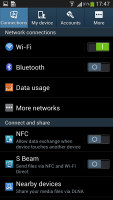
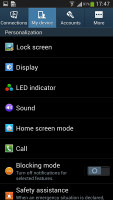

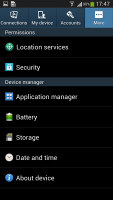
The revamped Settings menu of the Galaxy S4
Both the Galaxy S4 and Galaxy S III sport the Multi-Window feature. This lets you run two apps side by side on the screen. You can adjust the division line giving one app more space. Only compatible apps can be used with Multi-window, for now that means mostly the ones that come preinstalled on the phone.


The Multi-Window feature is supported on both devices
Thanks to its dedicated sensors and more powerful hardware, the Galaxy S4 comes with a number of advanced features that will not make it to the Galaxy S III in its future updates.
The first is Air View, which debuted on the Galaxy Note II and worked with the S Pen. There's no S Pen on the Galaxy S4, or a need for it - the phone simply can detect your finger hovering over the screen.



Air View turns your finger into an S Pen
This enables information preview (e.g. SMS text, calendar entry text and so on), previewing videos just by pointing to a spot in the timeline, the next track in the music player by hovering over the next button (works with previous button too), previewing folders, speed dial contacts, and magnifying links in web pages. Air view detects fingers 1cm / 0.5" away from the screen, so there's no danger of accidentally tapping the screen when you wanted to use Air View instead.
Another exclusive "air" feature on the Galaxy S4 is called Air Gestures. Those rely on the smartphone's built-in IR gesture sensor and mean that the phone can detect your palm waving over the screen.
You can use this to scroll web pages in the browser (vertical waves), switch between tabs (horizontal waves), move between tracks in the music player and photos in the gallery, accept a call and move app shortcuts and S Planner events.


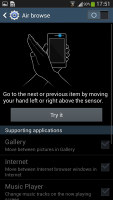
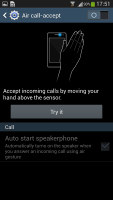
Air Gestures turns the S4 into a mini-Kinect
As we said, "Air" features rely on the Galaxy S4's infrared port, which the Galaxy S III lacks, so they won't be ported to the former flagship.
However, one of the new features that'd probably make its way to the Galaxy S III is Smart Scroll. It allows you to scroll up and down by tilting the phone or the tilting your head (you can pick between the two modes). It's a bit hard to get right at first but works well after that.
Smart Pause is the other new feature. While watching a video, it uses the front-facing camera to track your face and will automatically pause the video when you look away. Look back and the screen and the playback continues.

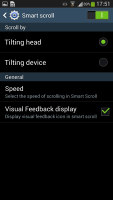
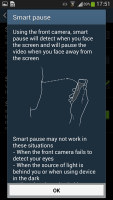
Smart Scroll and Smart Pause
A number of features have made their way from the Galaxy S III to the new flagship. There's direct call (dial the contact whose info you're currently viewing by lifting the phone up to your ear), smart alert (makes the phone vibrate when you pick it up if there are missed events), zooming and panning in the gallery, a shake of the phone to refresh the list of Bluetooth devices and muting alarms or pausing music playback by putting the phone face down.
There are also a batch of new and updated apps that currently only the Galaxy S4 can boast with. Among them are the updated S Voice, S Health and the newly introduced S Translator. Their arrival on the Galaxy S III is only a matter of time, which is also the case with Group Play and Samsung Link.
Overall, the Galaxy S4 brings more than enough software goodies to be a worthy upgrade over its predecessor. However, many of them will be making their way to the Galaxy S III as a part of its upcoming update, so it's just the hardware-specific ones that might justify dropping the old flagship for the new ones. And while stuff like Air gestures and S Health are undeniably pretty cool, you probably won't miss them all that much.
Synthetic benchmarks
Update, May 9: We added the I9500 Galaxy S4 benchmarks.As you have probably heard by now, the Samsung Galaxy S4 is available in two configurations. The first one is powered by an eight-core Exynos 5 Octa chipset, which offers two groups of four cores - one of the power-saving Cortex-A7 variety clocked at 1.2 GHz and the other of the extra powerful Cortex-A15 architecture running at 1.6GHz. Unfortunately that chipset proved quite hard to manufacture, so the majority of the first batch of Galaxy S4 units will be powered by the Snapdragon 600 chipset, just like our test unit. The Qualcomm-made SoC boasts four Krait 300 cores clocked at 1.9GHz, 2GB of RAM and Adreno 320 GPU.Standing in the opposing corner is the Exynos 4 Quad chipset, which while good for its time is clearly showing its age now. It features four Cortex-A9 cores running at 1.4GHz, 1GB of RAM (on the most popular international non-LTE version) and the Mali-400MP GPU. As you can see, in addition to the difference in CPU generations, there's also a notable difference in their clock speed. The GPUs are also fairly incomparable due to their generational difference.
Let's now see the margin of the victory that the Samsung Galaxy S4 is going to achieve here. We started with BenchmarkPi, which is a single-threaded CPU benchmark. The Galaxy S4 beat the achievement of its predecessor by more than two and a half times.
Benchmark Pi
Lower is better
- Samsung Galaxy S4 (Octa)
132 - Samsung Galaxy S4 (S600)
132 - LG Optimus G Pro
147 - HTC One
151 - Sony Xperia Z
264 - HTC Butterfly
266 - Oppo Find 5
267 - HTC One X+
280 - LG Optimus G
285 - Samsung Galaxy Note II
305 - HTC One X (Tegra 3)
330 - LG Optimus 4X HD
350 - Samsung Galaxy S III
359 - Meizu MX 4-core
362 - Nexus 4
431
Linpack
Higher is better
- Samsung Galaxy S4 (Octa)
791 - Samsung Galaxy S4 (S600)
788 - LG Optimus G Pro
743 - HTC One
646 - Sony Xperia Z
630 - HTC Butterfly
624 - LG Optimus G
608 - Oppo Find 5
593 - Samsung Galaxy Note II
214.3 - Nexus 4
213.5 - Meizu MX 4-core
189.1 - HTC One X+
177.7 - Samsung Galaxy S III
175.5 - HTC One X
160.9 - LG Optimus 4X HD
141.5
Geekbench 2
Higher is better
- Samsung Galaxy S4 (Octa)
3324 - Samsung Galaxy S4 (S600)
3227 - LG Optimus G Pro
3040 - HTC One
2708 - Sony Xperia Z
2173 - HTC Butterfly
2143 - Samsung Galaxy S III
1845 - LG Optimus G
1723 - LG Optimus 4X HD
1661 - iPhone 5
1601
AnTuTu
Higher is better
- Samsung Galaxy S4 (Octa)
26275 - Samsung Galaxy S4 (S600)
24716 - HTC One
22678 - Sony Xperia Z
20794 - LG Optimus G Pro
20056 - HTC Butterfly
19513 - Samsung Galaxy S III
15547 - Oppo Find 5
15167
Quadrant
Higher is better
- Samsung Galaxy S4 (Octa)
12446 - Samsung Galaxy S4 (S600)
12376 - LG Optimus G Pro
12105 - HTC One
11746 - Sony Xperia Z
8075 - HTC One X+
7632 - LG Optimus G
7439 - Oppo Find 5
7111 - HTC One X
5952 - Samsung Galaxy Note II
5916 - Samsung Galaxy S III
5450 - Meizu MX 4-core
5170 - Nexus 4
4567
GLBenchmark 2.7 Egypt (1080p off-screen)
Higher is better
- Samsung Galaxy S4 (Octa)
43 - Samsung Galaxy S4 (S600)
41 - HTC One
37 - Oppo Find 5
32 - Google Nexus 4
32 - Sony Xperia Z
31 - Sony Xperia ZL
31 - Sony Xperia SP
31 - Apple iPhone 5
30 - LG Optimus G Pro
30 - LG Optimus G
21 - Samsung Galaxy Note II
17 - HTC One X
11
Epic Citadel
Higher is better
- Samsung Galaxy S4 (Octa)
59.8 - Samsung Galaxy S4 (S600)
57.1 - HTC One
56.4 - Sony Xperia Z
55.6 - LG Optimus G Pro
54.2 - Nexus 4
53.9 - Asus Padfone 2
53.4 - LG Optimus G
52.6 - Samsung Galaxy S III
41.3 - Oppo Find 5
38.6
The superior CPU performance of the S4 gives it an advantage in JavaScript performance over the S III. In fact, the S4 is one of the fastest phones we've tested.
SunSpider
Lower is better
- Samsung Galaxy S4 (Octa)
804 - Samsung Galaxy S4 (S600)
810 - Samsung Ativ S
891 - Apple iPhone 5
915 - Nokia Lumia 920
910 - Samsung Galaxy Note II
972 - HTC One X+
1001 - LG Optimus G Pro
1011 - Motorola RAZR i XT890
1059 - HTC One
1124 - Samsung Galaxy S III
1192 - Meizu MX 4-core
1312 - Sony Xperia Z
1336 - LG Optimus G
1353 - HTC Butterfly
1433 - Nexus 4
1971 - Oppo Find 5
2045
Vellamo
Higher is better
- Samsung Galaxy Note II
2418 - HTC One
2382 - Sony Xperia Z
2189 - HTC One X (Tegra 3)
2078 - Samsung Galaxy S4 (S600)
2060 - Samsung Galaxy S4 (Octa)
2056 - HTC Butterfly
1866 - Oppo Find 5
1658 - Samsung Galaxy S III
1641 - LG Optimus 4X HD
1568 - LG Optimus G
1522 - Meizu MX 4-core
1468 - Nexus 4
1310
Still, it's worth keeping in mind that synthethic benchmarks show just raw performance, and both phones still offer buttery smooth experience in both user interface and apps or games. The Galaxy S4 does have an advantage as far as heavier games and general loading times are concerned, but it will matter mostly to very heavy users.
Camera features
The Samsung Galaxy S4 features a 13MP camera that captures photos of up to 4128 x 3096 pixels. There's a 2MP camera on the front and they can snap a photo or record video simultaneously.The Samsung Galaxy S III uses an 8MP camera sensor capable of snapping stills of up to 3264 x 2448 pixels. There is a front-facing 1.9MP camera too, but both can't be used simultaneously.
The Samsung Galaxy S4 camera interface builds on the Galaxy Camera UI. Its most advanced features are available on a carousel with descriptive images and text and once you're used to them you can switch to a grid, so each shooting mode is only a couple of taps away.




Samsung Galaxy S4 camera interface
Color effects are hidden at the bottom of the screen and they all get a simultaneous live preview to help you choose. Additional settings are available in the upper left, though you'd rarely use those. We're not very happy about Samsung unifying the still and video camera UIs though - if you're shooting 4:3 photos (which you should if you want the full 13MP resolution), you have to frame your videos on a 4:3 viewfinder that expands to 16:9 only after you hit record.
The Galaxy S III uses the old TouchWiz camera interface, which consists of two shortcut bars on each side of the viewfinder.
On the right bar you get the still camera / camcorder switch, a virtual shutter key and the gallery shortcut (which is a thumbnail of the last photo taken).




Samsung Galaxy S III camera UI
On the left you get several controls and the good news is that you can pick any four shortcuts to put there - you can easily have all frequently used features just a tap away. The fifth shortcut always points to Settings.
One cool extra about the Galaxy S4 UI, which Galaxy S III lacks, is that it allows you to set the role of the volume rocker - it can be a still camera shutter key, video camera shutter key or zoom lever. Also the S4 skips the lockscreen when you hit the Home key if the currently running app is the camera, which is great for shooting sprees.
Both Galaxy S III and Galaxy S4 offer camera shortcuts on their lockscreens.
The Galaxy S4 has a number of useful shooting modes not present in the Galaxy S III - 360 panorama, 360 photo (Photo Sphere), plus object removal, cinemagrams, Sound & shot (still image plus background audio from the scene), and Drama (takes several shots of a moving object and combines them in a single photo).
The dual-shot mode is pretty sweet as it solves the problem of who gets left out of the group photo (or video). You can move the inlaid picture and resize it, which is great if you need to move it out of the way of a specific object. You can see the image moving when shooting a video too, which is pretty cool. There are several different styles for the inlaid picture.

Dual-shot in action
Those are the exclusive features available only in the Galaxy S4, though we are sure the 360 photo (Photo Sphere) will become available on the Galaxy S III as well after the Android 4.2 update.
Both Galaxy smartphones have a few shooting modes in common - HDR photo, Burst Mode, Beauty Face, and Best Face.
The Galaxy S4 video camera doesn't have as many fancy shooting modes as the still camera, but dual shot is available and you can do slow-motion and time lapse videos. Slow-motion videos can go up to 8x slow down, but resolution drops to 800 x 450 and framerate to 15fps. Time lapse videos can speed things up to 8x, with resolution and framerate remaining at 1080p @ 30fps (time lapse actually requires less processing power than regular video capture).
The Galaxy S III camcorder interface is almost the same as the still camera's - you get the same customizable panel on the left for four shortcuts and a settings button. It is also capable of capturing 1080p @ 30fps, but can't do slow-motion and time-lapse videos.


Samsung Galaxy S III camcorder UI
Touch focus is available on both smartphones before and during video recording and you can switch back to continuous autofocus if you prefer. You can capture full res (cropped to 16:9 aspect) photos during recording as well.
Still camera quality
Update, April 12: We've finally got our hands on a Galaxy S4 unit, running retail software and we updated the shootout, using samples from it.We've prepared various crops to highlight the differences in image quality between the two smartphones and we've included the full-resolution shots to let you make your own comparisons.
First, let's talk Field of View (FoV) - how much can you fit in the frame with each camera. The Galaxy S4 camera turned out narrower than the Galaxy S III one, which lets you capture more without moving back, but it also means there are fewer pixels to describe each object. Here's an illustration of the FoV of the two smartphones.
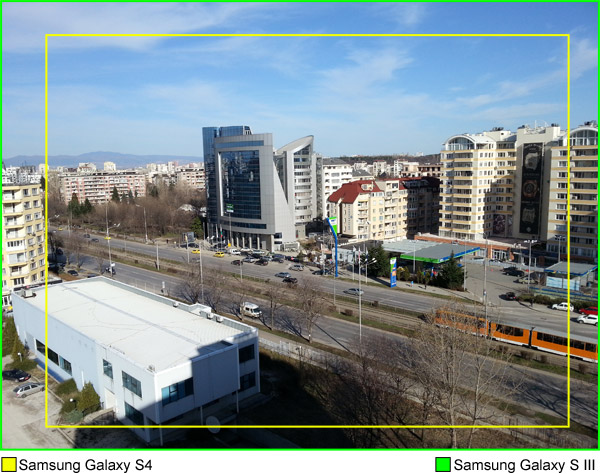
Then there's the difference in lens apertures to consider. The Galaxy S4 has a faster F/2.2 lens, compared to the F/2.6 maximum aperture on the Galaxy S III. This gives the new flagship an edge over it competitor in low-light conditions as it allows more light to reach the sensor. The two smartphones have similar image processing algorithms. They both produce photos with a lot of fine detail and very little noise. Pixel peepers will notice oversharpening halos, but it's nothing drastic. Colors are accurate if slightly oversaturated and white balance is somewhere between neutral and cold (typical for Samsung phone cameras). Both phones preserve detail in the shadows, rarely at the cost of detail in the highlights. That's where the HDR modes come in handy.

Since the Galaxy S4 has narrower field of view and a higher resolution sensor it gets more pixels for describing an object. As you can see from the crops and the samples, the extra 5MP make substantial difference, boosting the overall resolved detail quite significantly. There are small objects that are barely defined on the Galaxy S III pictures, and clearly pictured on the Galaxy S4 (leaves, branches, bars, face details on the macros, etc.).

We also snapped a couple of low-light shots. In these conditions the Galaxy S4 made great use of its faster lens and produced much better photos than its predecessor. The amount of detail is much higher and the noise is lower too. The second pair of crops here were produced with the flash on. As we told you earlier the Galaxy S4 has an advantage in that department as well, resulting in better exposed and generally much more detailed shot than the Galaxy S III.

Here are the full-res samples of the low-light shots.




Low-light and flash on: Galaxy S4 • Galaxy S III
Here are all the samples we took with the Galaxy duo.









Samsung Galaxy S4 camera samples









Samsung Galaxy S III camera samples
Here are some HDR shots too.




Samsung Galaxy S4 • Samsung Galaxy S4 HDR • Samsung Galaxy S III • Samsung Galaxy S III HDR
Finally, you can check our photo quality comparison tool. There you can see the Galaxy S4 and Galaxy S III give their best in the controlled environment of our studio. The field of view is compensated for here, but the extra resolution is still enough to give the Galaxy S4 a substantial advantage over its predecessor.
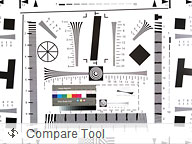
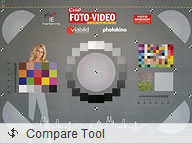

Samsung Galaxy S III and Galaxy S4 in our Photo Compare Tool
Video camera quality
Update April 12: We've reshot the videos with the unit running final software and updated the text below to reflect our new findings.Both the Samsung Galaxy S4 and the Galaxy S III shoot 1080p videos at 30fps. The bitrate for the Galaxy S4 is typically between 16Mbps and 17Mbps with stereo audio making up 128Kbps of that. The Galaxy S III goes only slightly higher with bitrates of 17Mpbs to 18Mbps and audio bitrate of 134Kbps.
The difference is Field of View is noticable, though - the Galaxy S4 fits less in the frame than the Galaxy S III. Just like with the stills though the narrower FoV will help resolve object that do fit in the frame.
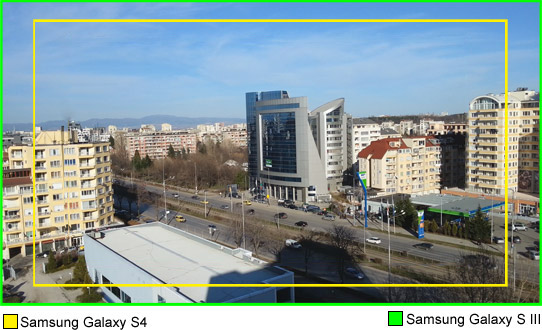
Videos captured with the Samsung Galaxy S4 have little noise and a good amount of fine detail but surprisingly aren't much better than those shot with the Galaxy S III. The colors are a tad more accurate on the new flagship, and there are less traces of oversharpening.The Galaxy S4 also has an advantage in terms of dynamic range, although it results in slightly lower contrast than that of the Galaxy S III videos. The Galaxy S III goes for a punchier output with more saturated colors and more aggressive sharpening, making its videos appear slightly sharper even if they don't have much extra detail.
Framerate is pretty solid at 30fps for both smartphones, so videos produced with either are pretty smooth.

Here is an untouched video sample from the Galaxy S4 you can download.
Here is an untouched video sample from the Galaxy S III you can download.
Surprisingly the Galaxy S4 videos get way more detailed when we turned on the digital video stabilization. Footage gets more detailed and contrast improves, which is pretty odd considering that we use a tripod for shooting those, so stabilization shouldn't matter a jot. It's obviously some kind of processing issue that Samsung needs to address with a future update. For now we'd recommend keeping video stabilization on, as long as you are not bothered by the field of view, which gets even narrower.

Here is the Galaxy S4 sample with the stabilization turned on:
Here is an untouched video sample with video stabilization from the Galaxy S4 you can download.
You can also take a close look at the quality of Samsung Galaxy S4 and Galaxy S III videos in our Video quality compare tool.


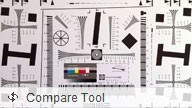
Samsung Galaxy S4 and Galaxy S III in our Photo quality compare tool
Image galleries
Samsung used the same gallery app in both Galaxy S4 and Galaxy S III. It can be sorted into albums, all photos and videos, time, location, etc. There's also a spiral option, which revamps the gallery into a Scalado-like spiral of images and video, which after a while gets really nauseating.You can pinch to zoom in the gallery and thus manage the size of the thumbnails.
Upon choosing an album (for instance Camera) you're taken into that albums' stack of photos but a swipe to the right will reveal a bar on the left with the albums. This lets you switch albums without returning to the main screen every time.




Galaxy S4 Gallery • Galaxy S III Gallery
When a press and hold on a picture the gallery gives you the option to select multiple images, which you can then mass delete, share, copy or move.
When viewing a single photo, you'll find several sharing shortcuts and a delete button above the photo, while below is a line of small thumbnails of all other photos in the album. You can tap those small thumbnails to move to other images or you can just swipe to the side.




Viewing image on Galaxy S4 • Viewing image on Galaxy S III
You can easily retouch photos in the Gallery itself. The photo editor gives you options like crop, rotate, color and effects. You can also make a memo on top of the picture.
The Gallery also supports highly customizable slideshows with several effects to choose from, customizable music and speed. You can also highlight specific images to be included in the slideshow.
Still, there are two features reserved only for the Galaxy S4 - Air view and Detect Text. Air view activates when you hover your finger above an image and you'll get a bigger thumbnail overview of the image. You can use it to peek inside folders too.
The nifty Detect Text option in the Galaxy S4's Gallery context menu does as advertised - it detects text on an image and converts it into a text file, which you can share via mail and messages or save a note. Keep in mind that it requires a data connection to work.



Galaxy S4 only: Air view • Detecting text
Music players
The two Galaxy smartphones feature almost identical TouchWiz Music Players, though the one on the Galaxy S4 has a few extra features under its hood - audio enhancements and floating touch gestures.Both players supports a wide variety of file formats, including FLAC, WAV, etc. Music is sorted by the usual Artist, Album, Playlist, etc. but there's also Folder support (which is more often found on third party players) - it's quite handy as it saves you the need to sort songs into playlists like on so many other players.
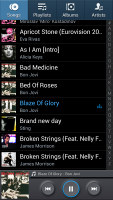
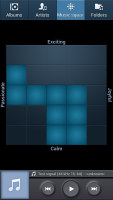


Music Player on Galaxy S4 • Music Player on Galaxy S III
Then there's Music square - it's quite similar to the SensMe feature of Sony smartphones. It automatically rates a song as exciting or calm, passionate or joyful and plots those songs on a square (hence the name).


Galaxy S4 equalizer • Galaxy S III equalizer
Samsung has enabled equalizer presets (including a custom one) along with the sound-enhancing SoundAlive technology, which features 7.1 channel virtualization.
The Now playing screen gives you the usual options - a timescroll of the song, play/pause and back/forth controls, repeat and shuffle, volume control but it also adds lyrics support, AllShare shortcut and a direct sound settings shortcut.




Now playing screen on Galaxy S4 • Now Playing screen on Galaxy S III
While listening to a song you can find music controls in the notification area and the lockscreen.
The Galaxy S4 couple of exclusive features will enhance your sonic experience further. One is Smart Sound, which equalizes the volume between tracks. The other is Adapt Sound - it plays a series of beeps (both high and low frequency) and asking if you can hear them. This way the phone can map the capacities of your specific headset and fine tune the sound.
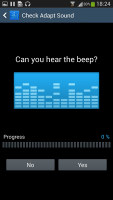
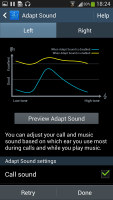
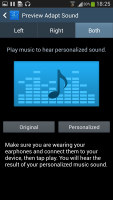
Galaxy S4 only: Adapt Sound
The music player of the Galaxy S4 also supports a few floating touch gestures, which of course are unavailable on the Galaxy S III.
Video players
The Galaxy S4 video player is an updated version of the player found on the Galaxy S III. Both players are capable of playing every video file you threw at them - DivX, XviD, MP4, MOV, MKV, etc. They also support the AC3 audio codec and rich subtitle fonts. Pop up play is available on both devices as well.The welcome page of both UI players feature the nice-looking grid view. The visible video thumbnails are actually playing the videos instead of being static images. They play at a reduced frame rate and generating those previews takes a while the first time around, but it's an awesome preview and it shows what can be done when you have processing power to spare.


Galaxy S4 video player • Galaxy S III video player
The chapter preview detects chapters in the video and shows a rectangular grid, with live thumbnails (just like the grid view above).
The player on the Galaxy S4 has the last watched video on top for quick access. Under it there are three tabs - personal (showing you the videos on your local storage), Download (which lets into the Videos store) and Nearby devices, which shows the PCs and players on your local Wi-Fi network.
The player on the Galaxy S III offers just the tabs (Thumbnails, List, Folders, Nearby devices), without the last played video on top.



Galaxy S4 video player • chapter preview
The exclusive Galaxy S4 features are same SoundAlive audio-enhancing technology available on its Music Player and the floating touch support. Hovering your finger over the timescroll lets you preview part of the video in a small thumbnail - just like YouTube videos do when you hover with your mouse.


Galaxy S III video player • chapter preview
Loudspeaker performance
We also tested the loudspeakers of the two handsets. Neither is exceptionally loud, both scoring a Good mark. Still, the Galaxy S III did slightly better in the Voice test.| Speakerphone test | Voice, dB | Ringing | Overal score | |
| Samsung I9505 Galaxy S4 | 70.6 | 66.2 | 77.3 | |
| 75.1 | 66.5 | 75.0 |
Final words
So, what may as well be last season's top smartphone against a hot favorite for this year's gold. Samsung must be proud of the fact that both carry its signature. Future Galaxy S4 users will feel safe knowing they're getting a future-proofed device that's very much in the running for best phone of the year. There will be a tinge of envy on the part of Galaxy S III owners for sure.There's nothing to be done about that. It's the new model vs. the old one. But the question rather is, do they need to do anything about it. The Galaxy S III has history while the Galaxy S4 is yet to make one. The Galaxy S III pretty much owned the competition for the best part of last year, while the Galaxy S4 snatched wins against recent fellow droids but is yet to face more challenges. iPhone 6 maybe, the new LG Optimus.
But while even the slimmest of wins against the likes of the Sony Xperia Z and the HTC One is a thing to be proud of and the indisputable fact that the Galaxy S4 is superior to its predecessor, it's not that easy to make a smartphone that sold over 50 million units obsolete.


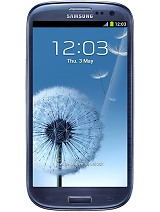
Samsung I9500 Galaxy S4 • Samsung I9505 Galaxy S4 • Samsung I9300 Galaxy S III
Sure, a 1080p screen is a must-have these days for a flagship but the difference isn't as striking as the jump from WVGA to 720p. The latest silicon is something that may set benchmarks on fire but the speed boost that's undeniably there isn't something that feels overwhelming in your hand. A 13MP camera isn't a minor upgrade either, but the Galaxy S III is still a solid cameraphone.
All in all, you can still get similar productivity out of the Galaxy S III - the big advantage of the Galaxy S4 is the future-proofing both in terms of software upgrades, but also things like processing power and screen resolution. The Galaxy S III stays relevant though and will probably even get some of the software tricks that are the other part of the S4's appeal via a software update. And that's without paying the price premium, which should be significant, at least in the first couple of months of the launch.
That's the thing though. If you're busy calculating in your head the worth of all those improvements and upgrades, you're probably not just ready to throw your Galaxy S III and replace it with a Galaxy S4 just yet. If, on the other hand, you think the smell of new is priceless, you probably have already preordered your next Galaxy smartphone. Nothing wrong though with Galaxy S III owners sitting on a fence. And we're sure for at least some of them the fence is the size of a Galaxy Note III.
As if you are only now considering purchasing one of those smartphones - the choice couldn't be easier. The Galaxy S4 is easily worth the extra cost over its predecessor and as long as you can afford it, that's the only one you should be looking at.
Subscribe to:
Comments (Atom)



